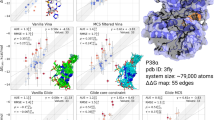Abstract
In May and August, 2016, several pharmaceutical companies convened to discuss and compare experiences with Free Energy Perturbation (FEP). This unusual synchronization of interest was prompted by Schrödinger’s FEP+ implementation and offered the opportunity to share fresh studies with FEP and enable broader discussions on the topic. This article summarizes key conclusions of the meetings, including a path forward of actions for this group to aid the accelerated evaluation, application and development of free energy and related quantitative, structure-based design methods.
Similar content being viewed by others
Explore related subjects
Discover the latest articles, news and stories from top researchers in related subjects.References
Bash PA, Singh UC, Brown FK, Langridge R, Kollman PA (1987) Science 235(4788):574–576
Wang L, Wu Y, Deng Y, Kim B, Pierce L, Krilov G, Lupyan D, Robinson S, Dahlgren MK, Greenwood J, Romero DL, Masse C, Knight JL, Steinbrecher T, Beuming T, Damm W, Harder E, Sherman W, Brewer M, Wester R, Murcko M, Fye L, Farid R, Lin T, Mobley DL, Jorgensen WL, Berne BJ, Freisner RA, Abel R (2015) J Am Chem Soc 137(7):2695–2703
D3R website at https://drugdesigndata.org/
See also:https://github.com/mobleylab/benchmarksets, http://doi.10.5281/zenodo.163963
Author information
Authors and Affiliations
Corresponding author
Rights and permissions
About this article
Cite this article
Sherborne, B., Shanmugasundaram, V., Cheng, A.C. et al. Collaborating to improve the use of free-energy and other quantitative methods in drug discovery. J Comput Aided Mol Des 30, 1139–1141 (2016). https://doi.org/10.1007/s10822-016-9996-y
Received:
Accepted:
Published:
Issue Date:
DOI: https://doi.org/10.1007/s10822-016-9996-y




